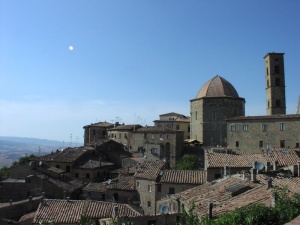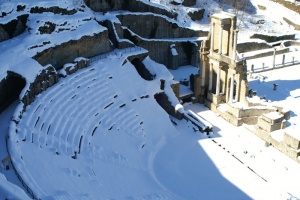Difference between revisions of "Volterra"
m |
m |
||
| Line 1: | Line 1: | ||
{{X}} | {{X}} | ||
'''Volterra''' is a town in the [[Tuscany]] region of [[Italy]]. | '''Volterra''' is a town in the [[Tuscany]] region of [[Italy]]. | ||
| − | + | [[Image:Volterra-Stemma copy.jpg|120px|right]] | |
==History== | ==History== | ||
The town was a [[Neolithic]] settlement and an important Etruscan center with an original civilization; it became a municipium in the Roman Age. The city was a bishop's residence in the fifth century and its episcopal power was affirmed during the twelfth century. With the decline of the episcopate, Volterra was the subject of the interest of [[Florence]], which defeated Volterra many times though rebellions sometimes took place. When the Florentian Republic fell in [[1530]], Volterra came under the control of the [[Medici]] family and later followed the history of the [[Grand Duchy of Tuscany]]. | The town was a [[Neolithic]] settlement and an important Etruscan center with an original civilization; it became a municipium in the Roman Age. The city was a bishop's residence in the fifth century and its episcopal power was affirmed during the twelfth century. With the decline of the episcopate, Volterra was the subject of the interest of [[Florence]], which defeated Volterra many times though rebellions sometimes took place. When the Florentian Republic fell in [[1530]], Volterra came under the control of the [[Medici]] family and later followed the history of the [[Grand Duchy of Tuscany]]. | ||
Revision as of 17:01, 27 April 2008
Volterra is a town in the Tuscany region of Italy.
History
The town was a Neolithic settlement and an important Etruscan center with an original civilization; it became a municipium in the Roman Age. The city was a bishop's residence in the fifth century and its episcopal power was affirmed during the twelfth century. With the decline of the episcopate, Volterra was the subject of the interest of Florence, which defeated Volterra many times though rebellions sometimes took place. When the Florentian Republic fell in 1530, Volterra came under the control of the Medici family and later followed the history of the Grand Duchy of Tuscany.
Main sights
- Roman Theatre (1st century BC), excavated in the 1950s.
- Piazza dei Priori, one of Italy's most beautiful squares.
- Palazzo dei Priori
- Cathedral of Santa Maria Assunta. It was enlarged in the 13th century after an earthquake. It houses a ciborium and some angles by Mino da Fiesole, a notable wood Deposition (1228), a masterwork of Romanesque sculpture and the Sacrament Chapel, with paintings by Santi di Tito, Giovanni Balducci and Agostino Veracini. In the center of the vault are fragments of an Eternal Father by Niccolò Circignani. Also noteworthy is the Addolorata Chapel, with a terracotta group attributed to Andrea della Robbia and a fresco of Riding Magi by Benozzo Gozzoli. In the nearby chapel, dedicate to the Very Holy Name of Jesus, is a table with Christ's monogram, allegedly painted by Bernardine of Siena. The rectangular bell tower is from 1493.
- Medicean Fortress (Maschio), now a penitentiary.
- Guarnacci Etruscan Museum, with thousands of funeral urns dating back to the Hellenistic and Archaic periods.
Outside the city, in direction of Lajatico, is the Medici Villa di Spedaletto. Also in the neighborhood, in the Valle Bona area, are excavations of Etruscan tombs.
Volterra in popular fiction
- Volterra is an important location in Stephenie Meyer's bestselling novel New Moon. In the story, Volterra is home to the Volturi, a type of royal family of vampires. They live under the city and use one of the ancient and beautiful buildings to lure tourists to their deaths.
- It is also mentioned briefly in Thomas Harris's Hannibal, by Inspector Pazzi to the kidnappper Carlo.
Twin cities
External links
- Town web site
- Tourism Office Web Site
- Web Site about Alabaster Craftmanship
- 360° Photo Tour & Information on Volterra
- Alabaster Craftsmen Association
- Volterra history and Etruscan Museum
- Template:En icon Guarnacci Etruscan Museum in Volterra
Gallery
| Tuscany · Comuni of the Province of Pisa | |||||||||||||||||||||||||||||||||||||||||||||||||||||||||||||||||||||||||||||
| Bientina | Buti | Calci | Calcinaia | Capannoli | Casale Marittimo | Casciana Terme | Cascina | Castelfranco di Sotto | Castellina Marittima | Castelnuovo di Val di Cecina | Chianni | Crespina | Fauglia | Guardistallo | Lajatico | Lari | Lorenzana | Montecatini Val di Cecina | Montescudaio | Monteverdi Marittimo | Montopoli in Val d'Arno | Orciano Pisano | Palaia | Peccioli | Pisa | Pomarance | Ponsacco | Pontedera | Riparbella | San Giuliano Terme | San Miniato | Santa Croce sull'Arno | Santa Luce | Santa Maria a Monte | Terricciola | Vecchiano | Vicopisano | Volterra | |||||||||||||||||||||||||||||||||||||||||||||||||||||||||||||||||||||||||||||













